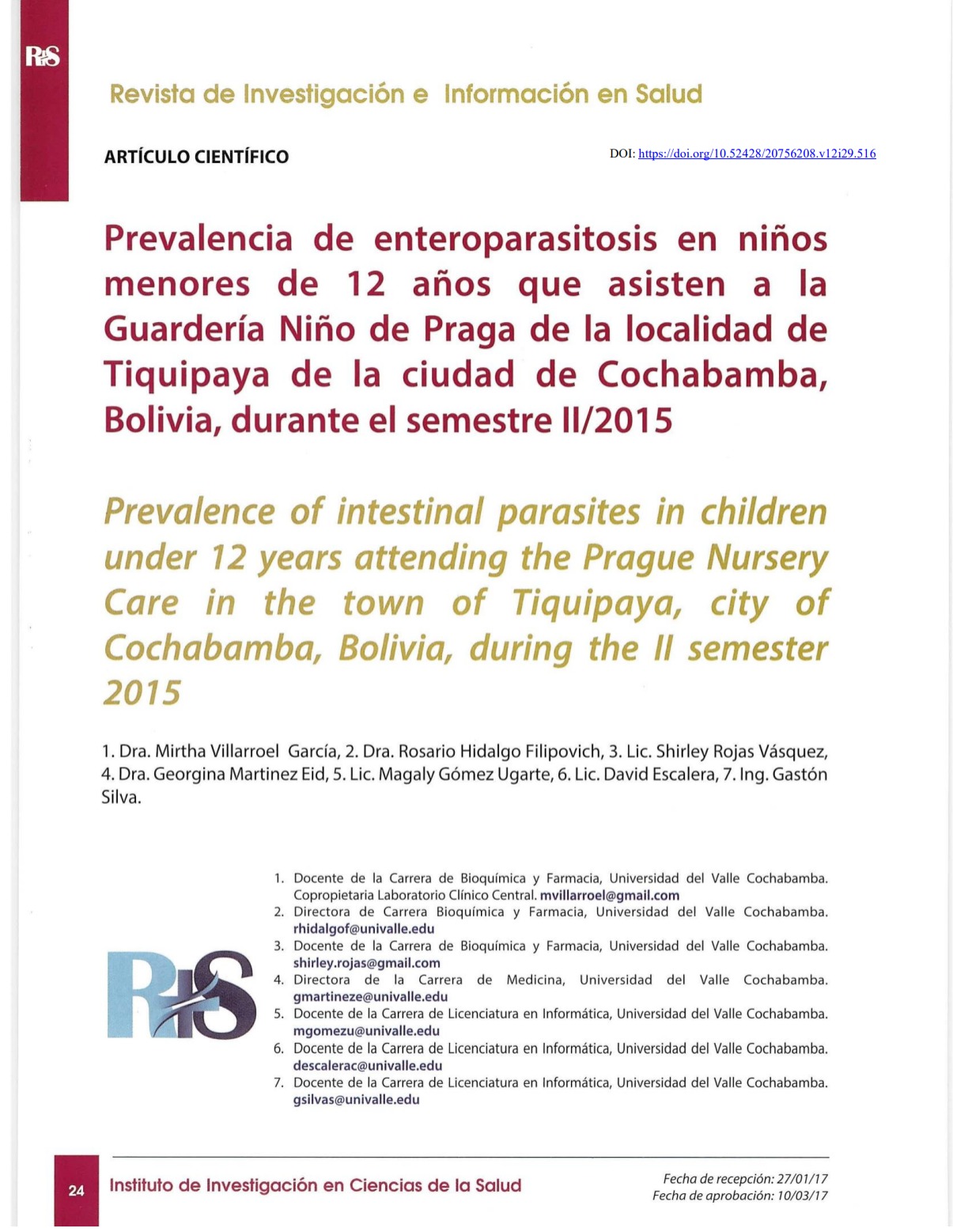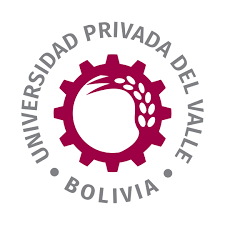Prevalence of Intestinal Parasites in Children Under 12 Years Attending the Prague Nursery Care in the Town of Tiquipaya, City of Cochabamba, Bolivia, During the ll Semester 2015
DOI:
https://doi.org/10.52428/20756208.v12i29.516Keywords:
Pathogenic parasites, Children, Protozoan, Helminths, CommensalAbstract
The objective of this study was to know the prevalence of enteroparasites in the Nursery Child of Prague, an institution that children from families with limited resources attend. The feces of 256 children whose ages ranged from 0 to 72 years were analyzed by means of a conventional coproparasitological analysis with the use of lugol to distinguish the morphology of the parasites. This is a descriptive and prospective study, in which we found that 62% of the children were parasitized by one or more species of commensal and / or pathogenic parasites. Regarding the parasitic species found, more than half of the children were parasitized by the protozoan Blastocystis hominis (53%), whereas only one case ofparasitosis was found by the helminth Enterobius vermicularis. Relating the age of the children to the parasitic species, we found that almost half of the children from 4 to 7 years had Blastocystis hominis, whereas helminths such as Hymenolepis nana and Enterobius vermicularis were found only in children older than 4 years. No cases of helminthiasis were found in children younger than 3 years. 97% of the children had one or more species of commensal protozoans, whereas only 72% had helminths. As for the number of parasitic species found, only 1% of the children had polyparasitosis cases, whereas 53% were parasitized by only one parasite (monoparasitism). It is concluded that more than half of the children attending this nursery suffer from some type of enteroparasitosis, a situation that can affect their development.
Downloads
References
1. Murray P, Rosenthal K, Pfaller M. Microbiología Médica. Sexta edición. España: Elsevier España, S.L.; 2009.
2. Pérez Cueto MC, Sánchez Álvarez ML, Cueto Montoya GA, Mayor Puerta AM,Fernández Cárdenas N, Alegret Rodríguez M. Intervención educativa y parasitismo intestinal en niños de la enseñanza primaria. Rev Cubana Med Gen lntegr.; 23(2). Di spo ni bleen: http://scielo.sld.cu/scielo.php?pid=S0864-21252007000200010&script=sci_arttext
3. Oberhelman RA, Guerrero ES, Fernández ML, Silio M, Mercado D, Comiskey N, et al.Correlanon between intestinal parasltosis, physical growth and psychomotor development among infants and children from rural Nicaragua. Am J Trap Med Hyg. 1998; 58(4):470-75. https://doi.org/10.4269/ajtmh.1998.58.470
4. Gavert B. Comparative study of the incidence and dissemination of intestinal parasites in chlld day care center of the district capital Schwerin. Gesundheitswesen 1998; 60:301-6.
5. Sanjurjo González E, Rodríguez M, Bravo JR, Fintay CM, Silva LC, Galvez MD, et al. Encuesta nacional de parasitismo intestinal. Cuba: Ministerio de Salud Pública; 1984:111.
6. Joyce T, McGuigan KG, Elmore MM, Conroy RM.Prevalence of enteropathogens in stools of rural Maasai children under five years of age in the Maasailand region of Kenyan Rlft Valley. East Afr Med J 1996; 73:59-62.
7. McDonald V. Parasites in the gastrointestinal tract. Parasite lmmunol 2003; 25:231-4. https://doi.org/10.1046/j.1365-3024.2003.00629.x
8. WHO. Prevention and control of intestinal parasitic infections. Tech Re Ser: WHO Expert Committee; 1987. Report No. 749.
9. Bórquez C, Lobato I, Montalvo M, Marchant P y Martínez Enteroparasitosis en niños escolares del valle de Lluta. Arica - Chile. Parasitol Latinoam 2004.59: 1 75 - 178. https://doi.org/10.4067/S0717-77122004000300016
10. Cardona-Arias J. Rivera-Palomino Y, Carmona-Fonseca J. Parasitología pediátrica. Salud indígena en el siglo XXI: parásitos intestinales, desnutrición, anemia y condiciones de vida en niños del resguardo indígena Cañamomo-Lomaprieta, Caldas-Colombia. Revista de los estudiantes de medicina de la Universidad Industrial de Santander. MéD. UIS. 2014; 27(2):29-39.
11. Rodríguez Ulloa C, Rivera J, Cabanillas Vásquez Q, Pérez Huancara M; Blanco H; Gabriel Gonzales J; Suarez Ventura W. Prevalencia y factores de riesgo asociados a parasitosis intestinal en escolares del distrito de los baños del inca, Perú. UCV - Scientia 2011 3(2).
12. Londoño-Franco L, Loaiza-Herrera J, Lora-Suárez F Gómez-Marín J. Frecuencia y fuentes de Blastocystis sp.en niños de O a 5 años de edad atendidos en hogares infantiles públicos de la zona urbana de Calarcá, Colombia. Biomédica 2014; 34:218-27. https://doi.org/10.7705/biomedica.v34i2.2124

Downloads
Published
How to Cite
Issue
Section
License
Copyright (c) 2017 Mirtha Villarroel García, Rosario Hidalgo Filipovich, Shirley Rojas Vásquez, Georgina Martinez Eid, Magaly Gómez Ugarte, David Escalera y Gastón Silva

This work is licensed under a Creative Commons Attribution 4.0 International License.
Authors who publish with this journal agree to the following terms:
- Authors retain copyright and grant the journal right of first publication with the work simultaneously licensed under a Creative Commons Attribution License 4.0 that allows others to share the work with an acknowledgement of the work's authorship and initial publication in this journal.
- Authors are able to enter into separate, additional contractual arrangements for the non-exclusive distribution of the journal's published version of the work (e.g., post it to an institutional repository or publish it in a book), with an acknowledgement of its initial publication in this journal.
- Authors are permitted and encouraged to post their work online (e.g., in institutional repositories or on their website) prior to and during the submission process, as it can lead to productive exchanges, as well as earlier and greater citation of published work.






















